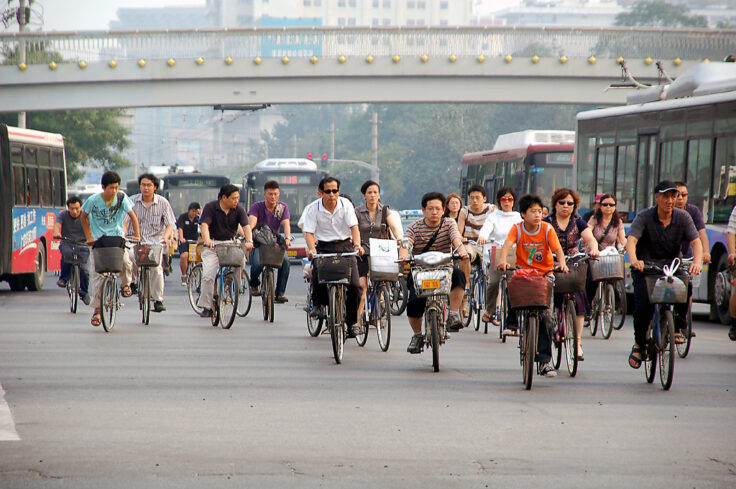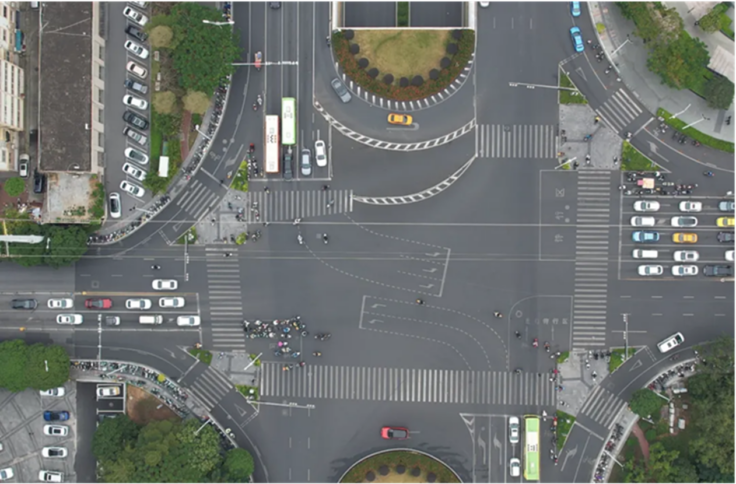April 09, 2025
How This Chinese City Is Improving Governance of E-Bikes and Two-Wheelers
Nanning, located in Southern China and home to more than 8.5 million people, is often known as the country’s “Green City” because of its lush parks, treescapes, and warm climate.
Read a version of this article in Chinese on ITDP China’s WeChat channel.
The city is now also earning a reputation as a capital for e-bikes and electric two-wheelers, with a reported per capita ownership of one e-bike for every 1.5 residents. With expanded infrastructure, facilities, and programming, Nanning has become one of the friendliest cities for cyclists. It is important to note that China’s e-bikes commonly feature a throttle, allowing motors to provide power without riders needing to pedal. Therefore, these fleets of e-bikes are more like scooters or light mopeds, rather than traditional electric-assist pedal bikes, but are still required by national regulations to only have a maximum speed of 25 km/h along with other maximums for weight, engine power, and battery voltage. These e-bikes represent a major mode of micromobility for millions of Chinese.
Nanning has gradually formed a set of management models to govern the growth and popularity of these two-wheelers. This includes the development of more dedicated non-motorized traffic lanes, vehicle signal lights, dedicated river crossings, and e-bike parking spaces and charging depots throughout the city. Nanning’s innovative approach to e-bike management can provide a model for other cities to follow as this mode is becoming increasingly popular for leisure, daily commutes, and goods delivery. Strategic measures like those enacted by Nanning not only optimize the built environment for cyclists but will also allow cities to reap electric mobility’s economic, social, and environmental benefits.

Nanning’s E-Bike History
With the continuous growth of its urban population, Nanning’s transportation demand is increasing daily, and e-bikes have gradually become the main means of transportation for most residents. The rapid development of e-bikes in Nanning comes from the city’s unique geography, cultural background, and strong association with using two-wheelers. In fact, in the 1990s, the popularity of traditional motorcycles in Nanning earned the city the title of “city of motorcycles” in China.
However, the unregulated expansion of these motorcycles also brought congestion, air quality issues, and safety concerns. In 2002, the city began to restrict traditional motorcycle registrations. With these restrictions, e-bikes emerged as an ideal alternative due to their flexibility, travel speed, and low entry barriers. By the end of 2023, the number of electric bicycles in Nanning had exceeded 4.8 million, far above even the number of private motor vehicles and cars. The mode share of e-bikes used in public travel has also reached nearly 37% as of 2021.
Recognizing this transformation, Nanning has worked to actively respond to the development needs of e-bikes. Several city departments jointly issued a series of regulations and management measures to standardize usage and operations. Since 2013, Nanning has officially implemented a registration system for e-bike owners, and as the number of e-bikes increases, officials are working to develop an innovative management model to respond to local mobility characteristics.

Access ITDP’s E-bikes: Charging Toward Compact Cycling Cities report in English.
Improving Governance on the Road
Problems such as traffic management, charging and parking, and safety awareness have also arisen with e-bikes, bringing new challenges to Nanning’s streets. As a result, the municipal government has carried out street re-design work from multiple dimensions, such as ensuring the right of way for cyclists, tackling the problem of charging and parking, creating more enforcement laws, and guaranteeing e-bike passage on roads. This change includes several notable steps:
- First, the city has optimized the original motorcycle lanes by constructing lines, guardrails, and non-motorized lanes with a general width of more than three meters to effectively separate bikes from motorized lanes. It has also designed a non-motorized vehicle bypass near bus stops to ensure the safe connection of various travel modes.
- Second, to cope with intersection congestion, the city has set up non-motorized vehicle lanes and waiting areas at the intersections of major arterial roads and significantly improved the traffic capacity and safety of non-motorized vehicles by optimizing signal timing and adding LED guidance.
- Finally, Nanning has built several non-motorized vehicle tunnels and passages for traffic nodes. All these tunnels are equipped with special non-motorized vehicle passages to separate non-motorized vehicles and improve travel safety.

Addressing Charging and Parking
Adequate storage and charging facilities for millions of e-bikes are also paramount. To address this, Nanning has formulated plans for different types of communities by constructing public charging facilities according to local conditions. For example, in denser or older neighborhoods, the city has opened up special charging areas or set up charging piles outside the community to provide space for electric facilities.
Promoting the cooperation between enterprises and property management committees is essential to solving the problem of who will build and manage these e-bike facilities. Residents should be guaranteed access to public facilities safely, conveniently, and affordably. At the same time, Nanning should vigorously promote charging and battery swapping areas to meet the rapid replacement needs of high-frequency users, especially delivery drivers, and to mitigate charging concerns.
In addition, to alleviate the parking pressure around destinations with high demand for non-motorized vehicles, the city’s traffic management department has begun to adjust some on-street parking spaces for e-bikes. Notably, one motor vehicle parking space can be used for nearly eight electric two-wheelers, effectively balancing the parking needs of different travel modes in limited street space. Thus, parking reforms to reclaim underutilized on- and off-street space for cars are crucial for e-bike operations.
Access ITDP China’s full report on Nanning’s e-bike strategies, available in Chinese, here.
Improving Guidance and Awareness
Nanning has established a governance system for e-bike management through detailed oversight and law enforcement. Since 2013, the municipal government has incorporated the traffic management of e-bikes into the overall planning of its urban transport strategies. In 2020, the “Nanning Electric Bicycle Management Regulations” were issued to strictly regulate the production, sale, registration, parking, and charging of e-bikes to ensure the standardization of their management.
In addition, the Nanning traffic police have also implemented a new outreach strategy, including source management, learning and education, traffic rectification, publicity and guidance, and more. In response to the problem of low road safety awareness, the Nanning traffic police launched a push to establish “learning points” at key intersections. Implementing traffic safety education for violators has also achieved remarkable results, and the rate of bicycle helmet use and illegal driving behaviors have been significantly improved.
In addition, Nanning also stepped up publicity and guidance efforts, setting up signs at intersections, conducting face-to-face publicity, and devising traffic safety education activities for different communities. Through these measures, Nanning has successfully refined and humanized e-bike management, ensuring the orderly operation of traffic and the safety of citizens.
Lessons for Global Cities
Nanning’s successful practice governing e-bikes has significant potential for replication in other cities. The Nanning experience effectively responds to local traffic problems and actively explores a sustainable development path for all transport modes. The city government began by emphasizing better governance of e-bikes and putting the right of way for cyclists ahead of larger motor vehicles in policy designs.
Through the formulation of detailed strategies, such as “Regulations on the Administration of Electric Bicycles in Nanning“, a solid legal foundation has been provided for the day-to-day management of e-bike usage. The policy’s comprehensiveness and operability ensure effective implementation and provide an important reference for other cities’ policy formulation. Nanning has demonstrated a forward-looking approach to infrastructure design and technological innovation, especially in constructing non-motorized lanes, optimizing intersection management, and creating special tunnels and bridge passages.
The city also continues to take a multifaceted and adaptive approach to solving the difficulties of charging, parking, and safety and operational awareness. Other cities can learn from this to better plan and construct e-bike facilities according to unique local needs. Finally, the Nanning traffic police implemented a flexible law enforcement model that has helped broaden drivers’ safety awareness and effectively maintained traffic order.
Other cities can learn from Nanning’s policy tools and designs to improve the efficiency and effectiveness of their own urban mobility strategies.
